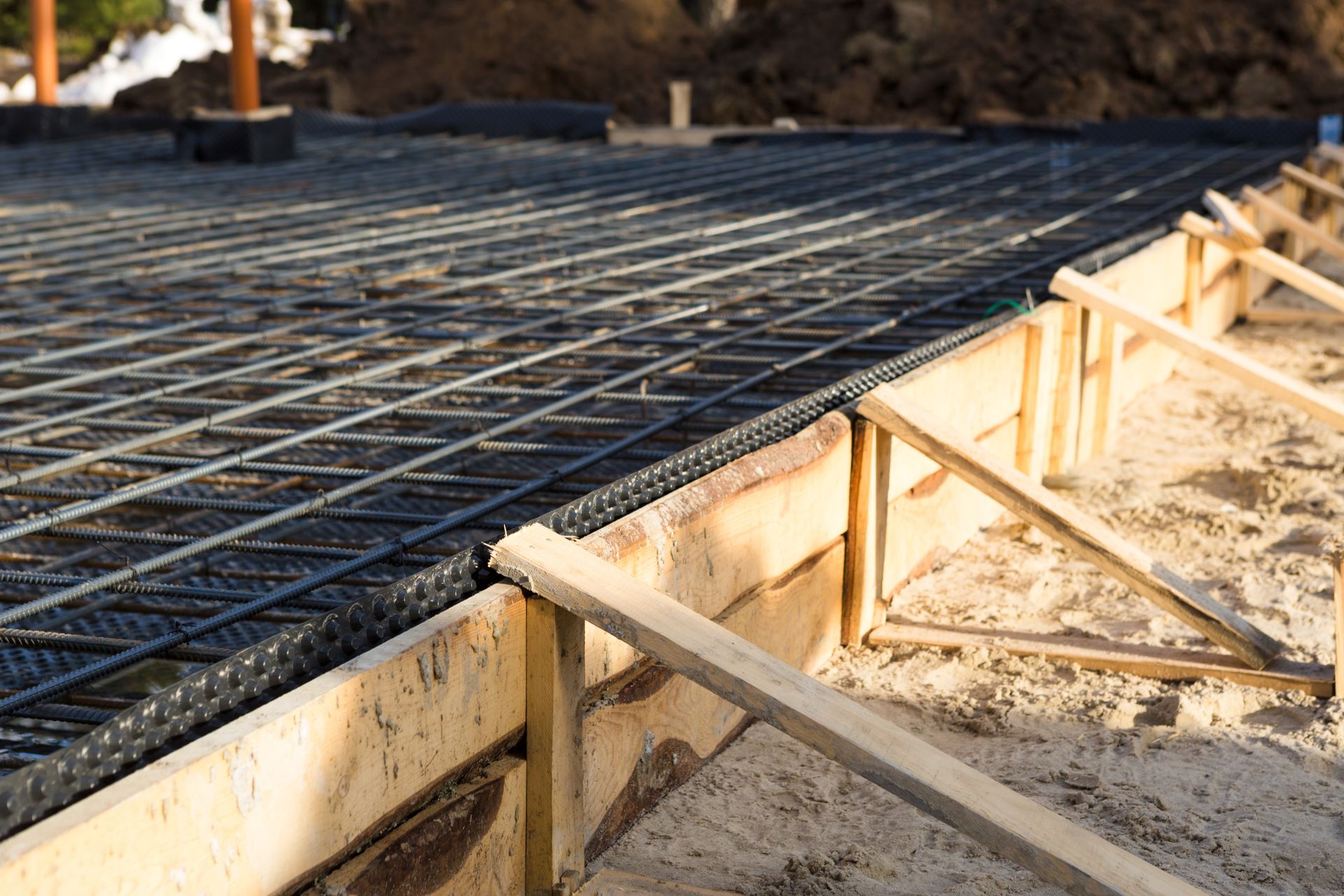Specializing in Concrete Contractor, Concrete Company and Concrete Driveway Contractor
Houston, Tomball, Cypress, TX
Steel Reinforcement
Concrete is a construction material that consists of cement (commonly Portland cement) as well as other cementitous materials such as fly ash and slag cement, aggregate (generally a coarse aggregate such as gravel, river rock gravel, limestone or granite, plus a fine aggregate such as sand or manufactured sand and water) and chemical admixtures. There are several types of cement, but for residential use type "A" is generally used. The other types are for special purpose applications such as "high early" cement used when a rapid cure must be effected for the concrete. And there are many other types of cement used for special applications for the concrete.
Many people call concrete "cement." This is like calling a cake "flour." Cement to concrete is like flour to cake. Flour is certainly a requisite ingredient and goes far in making the cake - cake; but flour is only a part of the formula. Cement is the same way. It is a vital ingredient in concrete but it is only a part of the entire composition of concrete. What is important to know is that cement is like the "glue" that bonds everything else together. If you want strong concrete that does not crack (if control joints are spaced correctly), then add more cement or increase the PSI (pounds per square inch of compressive strength), of the concrete. For residential applications 3000 PSI is the norm.
Concrete solidifies and hardens after mixing and placement due to a chemical process known as hydration. The water reacts with the cement, which bonds the other components together, eventually creating a stone-like material. It is used to make pavements, architectural structures, foundations, motorways/roads, overpasses, parking structures, brick/block walls and footings for gates, fences and poles. Concrete is the NUMBER ONE material in the world used for building, roads, infastructure, buildings, dams, and any type of construction requiring strength over time.
Concrete is used more than any other man-made material on the planet... As of 2010 about eight billion cubic meters of concrete are made each year, which equals one cubic meter for every person on Earth. Concrete powers a $40 billion industry in the United States which employs more than two million workers. More than 65,000 miles of freeways and highways in America are made of this material not to mention that over 95% of buildings have some concrete in their design or structure. Concrete is the number one material for foundations for both residential and commercial buildings, structures, high-rises, bridge supports and anything requiring a solid foundation.
Knowledge You Should Have About Reinforcement
The vast majority of people in the greater Houston area believe that the amount of steel or rebar you put in the concrete has a direct correlation to the strength of the concrete. They also believe that if you put a lot of rebar into the concrete it stops it from cracking. Neither of these statements are true!! The number one cause of indiscriminate cracks in concrete is either lack of; or improperly placed control joints !!!! When placing a "slab on grade application" like a driveway or patio, walk, etc. - the ultimate compressive strength of the concrete is based upon how solid the grade is upon which it is placed. It is very important to understand the correlation between the sub-grade and concrete strength! Think about putting concrete on jello as opposed to putting it on a solid base. That's why on commercial jobs as well as on freeways, streets and any commercial roadway - the sub-grade is developed extensively prior to placement of the concrete.
What reinforcement does on a slab on grade application, is to prevent the expansion of a crack once the crack has developed!! This may sound strange, but nonetheless - it is true. One can put 1/2 inch rebar in the concrete or even 5/8 inch but in the final analysis, the strength is based upon what the concrete is placed on as well as the ultimate strength of the concrete initially. If the sub-grade is not solid, then one cannot expect the concrete to have a solid foundation and the concrete will mirror whatever it is placed on. For example, if there is a problem with the sub-grade, expect to see problems with the concrete on top. Many people experience this when they see the concrete "shift" or fall and or crack indiscriminately.
WWF or wire mesh, has 6 inch centers whereas steel reinforcement can be placed on 12, 14, 16, or 18 inch centers. 18 inch centers is the most common application of rebar in slab on grade applications such as residential driveways, etc. In the final analysis, wire mesh does a better job than steel rebar because the 6 inch spacing does a better job of stopping the crack from developing than the 12 to 18 inch spacing on the rebar. Steel reinforcement "does not" add to the compressive strength as much as is believed, but becomes a trade-off against the prevention of crack expansion. That's why one sees so much steel placed in commercial work. Steel is a requirement for all cities when placing driveway aprons. (the part of the drive from the street to the walk). In the final analysis - you, the homeowner, dictate what we use for reinforcement. Our mantra is --- what is your peace of mind worth?
Curing Compound
Curing compound is merely a liquid agent that forms a film over the concrete to prevent the water from escaping too rapidly. Think of it as a blanket over the concrete. There are many types, but the most common is a latex based water soluble type because of the cost as well as the effectiveness. Other types are oil based but are prohibited in some states. Curing compounds are rarely used in Houston, however they are useful in areas adjacent to salt water to prevent rapid deterioration of the concrete during the initial hydration process. Use of a curing compound is essential in hot climates.
What About Wood Joints?
Unfortunately 90% of the driveways in the greater Houston area have wood used for control joints. First we must learn the definition of a control joint. A control joint means the contractor controls where the concrete will crack - it's that simple, but essential to good concrete work! Concrete cracks because it never completely cures. Therefore it retains a water content for over 50 years. The water content causes the concrete to expand and contract which ultimately causes it to crack. We know that a 4 inch slab with a mass over 120 square feet will crack regardless of how much reinforcement is placed into it !! A control joint makes it crack along straight and even lines therefore maintaining the cosmetic look of the concrete slab. Control joints also act as a conduit for water which is the biggest enemy of concrete.
In the houston area wood is used as control joints. Although Concrete Specialists will install wood joints per the owners request - we do not recommend wood in concrete!! Since concrete retains water for such a long period and is extremely caustic; and wood (even treated wood) is so porous, the wood rots out quickly and the homeowner is left with a 3/4 (three quarters of an inch), inch gap between his slabs. Wood and concrete are enemies. Concrete attacks anything one places into it, therefore wood is at a severe disadvantage when placed in concrete. Wood and concrete should not be used together!!! The only way to place wood in concrete is to create a plastic barrier in some fashion between the wood and concrete.
We use a joiner and/or saw-cutting to establish control joints. The joiner depresses the slab 3/4 to 1 inch and performs the same (if not better), function as the wood joints. Moreover, you still have 3 1/4 inches of concrete below the joint which will never rot and helps prevent grass from growing between the joints. This type of joint also acts as a conduit for water. When possible water should be kept from getting below the concrete surface because once the sub-grade is compromised, there exists no support for the concrete and a crack or settling will occur. Once water gets beneath your concrete many things can happen --- all of them bad!!!


